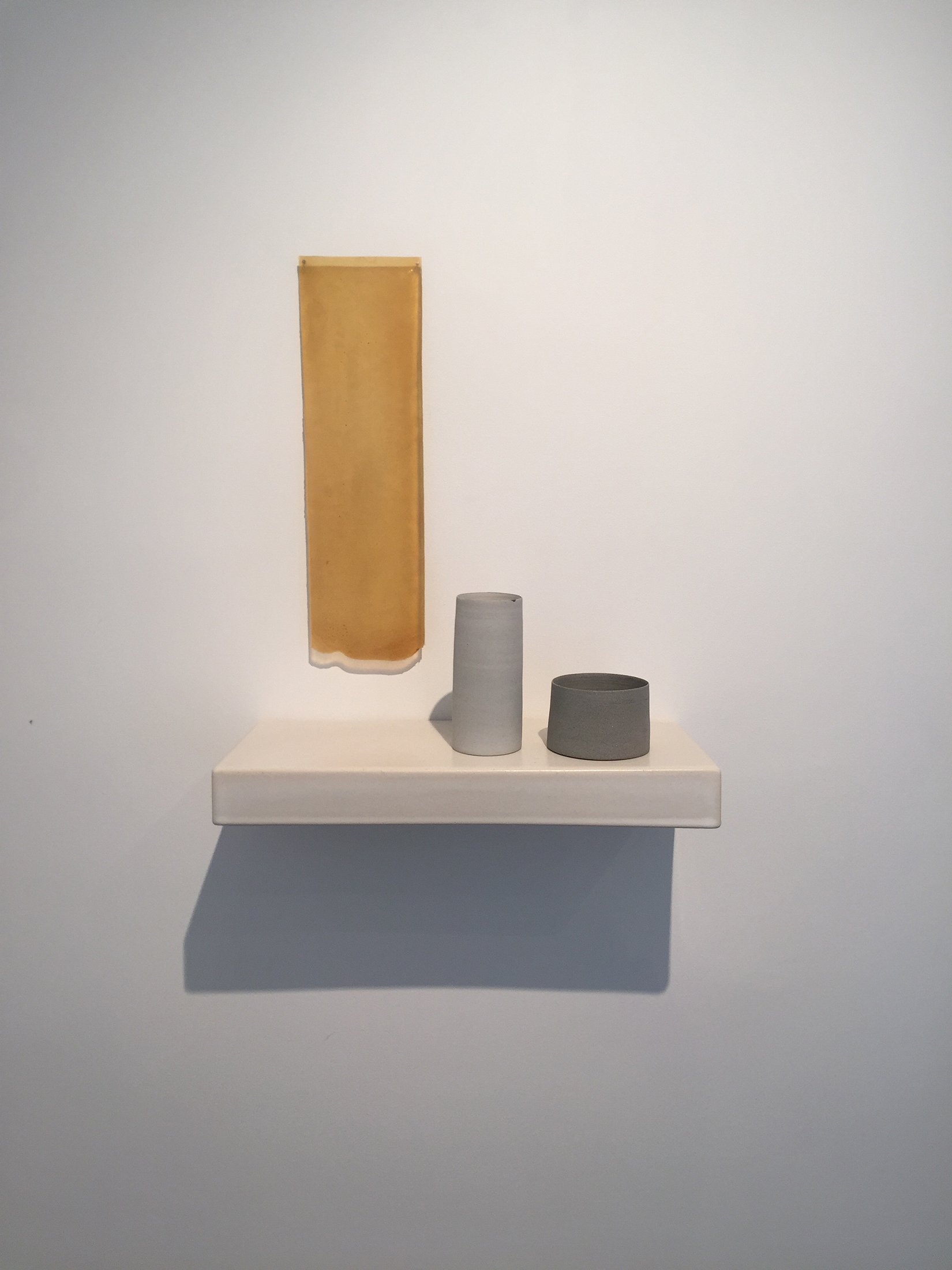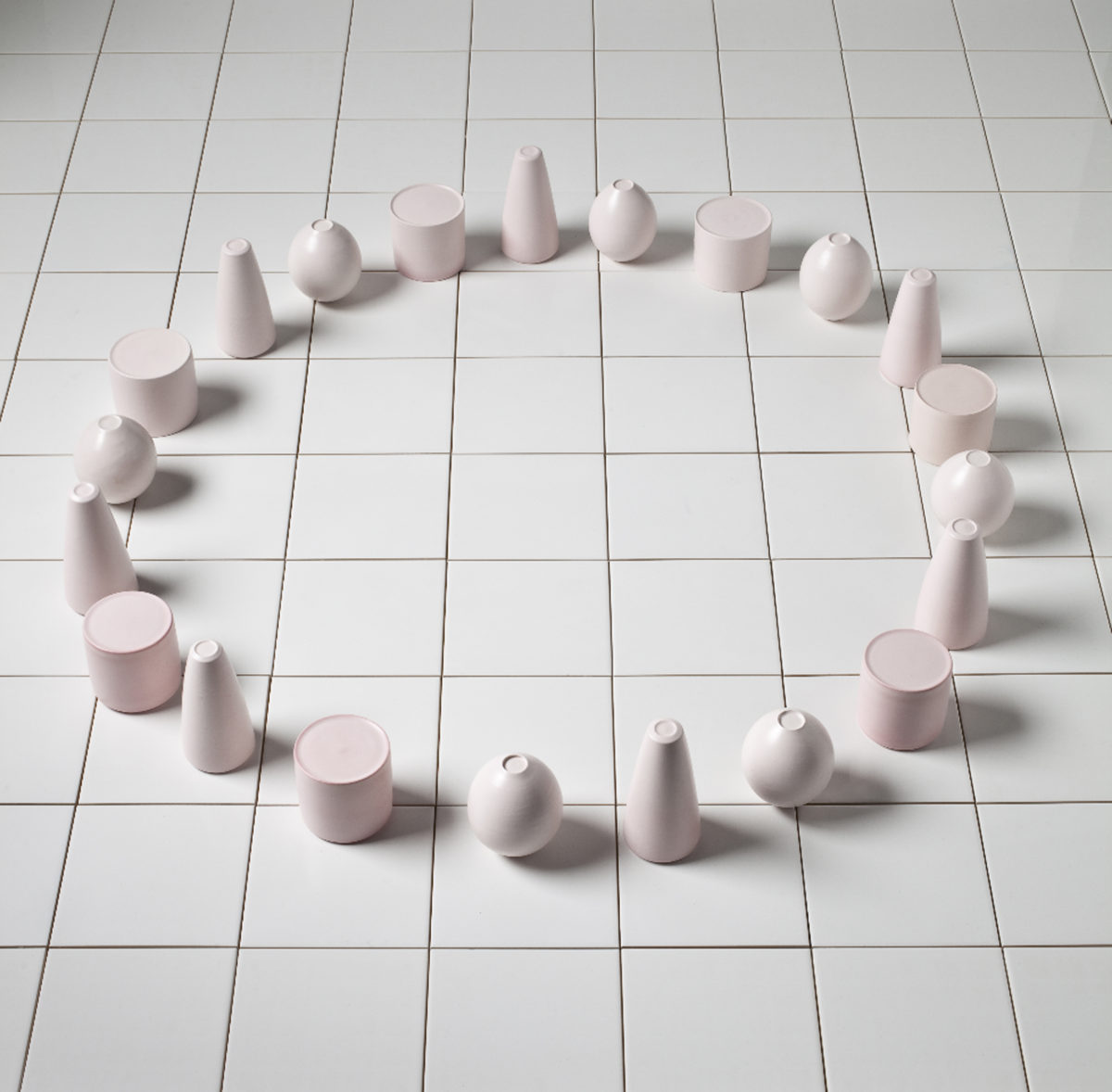Stillness in the Glorious Wilderness
Glenn Adamson
“She is an arranger by nature, active not only as an artist in her own right but also as a curator of other artists’ work.”
Marie T. Hermann, Stillness in the Glorious Wilderness #1, 100x100x11cm, Stoneware, 2010. Photo by Tim Thayer
Stillness in the Glorious Wilderness: the phrase reminds me of that old riddle about a tree falling in an empty forest. Does it make a noise? How could we know one way or the other? One thing is for sure. The tree doesn’t care. Looking around Marie Torbensdatter Hermann’s most recent exhibition of work, we may well have a similar feeling: that we are in the presence of pots that don’t quite need us. They are just fine on their own, thank you. Poised atop their handmade clay shelves, microcosms like the implacably calm still life paintings of Morandi, or set out in a neat ring on the gallery floor, these ceramic sculptures have a quiet assurance, an ease that belies the difficulty of their own making. You almost have to remind yourself that it’s by no means easy to create this sense of completeness. The usual way of doing it is to make objects that are resolutely alien to everyday experience: the abstract geometries of De Stijl, the weird and hermetic object-poems of the Surrealists, the industrial quality of Minimalist sculpture, or the unearthly light and space created by artist James Turrell. While Hermann’s work is influenced by all of these art historical references, she appeals to something more humble and humane than any of them. As is true of most potters, even those working in the manner of installation artists, daily use is constantly at issue for her – either as a haunting presence or a conspicuous absence. The inclusion of two plates, one sunk into its shelf and the other just emerging, gratifies our expectations on this score, even as the closing off of vases at the mouth refuses it. For this group of work, Hermann has gone deeper into the symbolism of human experience than she has in the past. A gentle glaze, pink in color and matte in texture, sheathes many of the objects, giving them the quality of bodies slightly flushed from heat, or pleasure, or effort. And in a more striking departure from form, she has included objects that are not thrown, but rather pinched into existence. With their pocked surfaces and approximate forms, they are suggestive of pots made either by young children or avant-garde artists (a long list that stretches from Peter Voulkos and Stephen DeStaebler through Nicole Cherubini and Rebecca Warren). In the context of the exhibition, they come off as one half of a balancing act. Hermann can do clinical precision with the best of them (you’ll not find a potter who surpasses her skills at the wheel). But more than in the past she also seems ready to let go, to experiment with an amorphous tactility. None of this tells us how she has managed to keep the pots so very OK with themselves, so happy in their skins. Partly this is simply a matter of design. Some of the forms she has used here are vaguely reminiscent of Eva Zeisel – the Hungarian-born modernist who more than any other 20th century potter found an ideal balance between abstraction and tactility. The shelf-bound vases that Hermann has made, for example, swell at mid-point or base, as if holding their breath; it’s the kind of barely-anthropomorphic idea that Zeisel has repeated over and over through her long career. But of course, these are not dinner wares, and Hermann’s forms can only be understood within the context of their manner of presentation. She is an arranger by nature, active not only as an artist in her own right but also as a curator of other artists’ work. Paradoxically, she has created a sense of pervasive autonomy through finely calibrated contingency. Not a single object in this exhibition is presented on its own. Her forms may be realized with authority, but just as important to the overall aesthetic are the negative spaces between the silhouettes, as well as relative positions of shelves on walls, rhymes between one object and another, and (especially in the circular composition that is the exhibition’s centerpiece) the rhythm of one pot after another. What gives Hermann’s work its air of serene self-sufficiency, then, is her ability to create an impression of unity even as she embraces variation. No artist has been more important to her over the years than Donald Judd, who set himself precisely the same objective; he spoke of creating ‘gestalts,’ that is, shapes that were internally complex but indivisible, whole in themselves. He often relied on mathematical progression to achieve this effect. A wall-mounted work might consist of hollows and rounds at regular intervals, increasing in a regular progression from left to right. Somewhat surprisingly, however, despite this seeming distrust of the arbitrary, Judd was happy to indulge his sense of color and texture, covering his work with luscious sprays of reflective automobile lacquer, or making it from burnished brass. He understood that his forms would seem even more inevitable if he was emphatic about their materiality. Hermann has absorbed all these lessons from Judd, yet her work also offers something that his does not. For all his power as a sculptor, there is something in his desire to subsume difference within the whole that I find slightly inhuman, even a bit terrifying. (Remember the etymology of fascism. It comes from fasces, the bundle of sticks that Romans used as a symbol of collective strength: you could snap any one of us, but together we are invincible.) In Hermann’s case, the polarity seems reversed. While her commitment to achieving a unified aesthetic impression is total, it seems to me that her greatest interest as an artist comes at the level of the detail. Yes, she knows she must (according to some modernist logic) ‘earn’ the right to create an interesting shape, like a sharp break in the profile of a vase, or a gentle curve in the rim of a plate. For her, these subtle touches have to make sense within an overriding context. There is nothing whimsical about them. But all the same, Hermann infuses these little maneuvers with a great deal of enjoyment – just as the slight sway of a violin or the mournful swell of an oboe might convey the emotion that a composer feels for his own symphony. Hermann’s pots may inhabit worlds of their own, and to that extent they stand proudly and resolutely apart. But through the deft and playful touches that are everywhere in this exhibition, we are let into something very human indeed: something not too far from bliss.
Originally published in 2009.

Marie T. Hermann, Northern life, Pontiac rise # 1, 2016.

Marie T. Hermann, Pontiac # 1, 2016. Photo by Galerie NeC. Paris, Fr.
